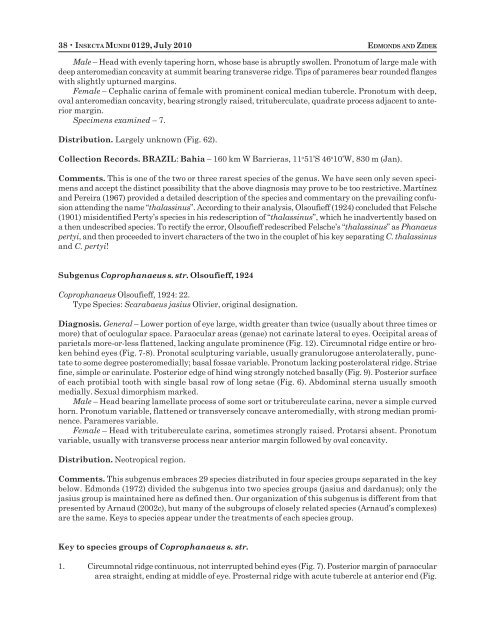insecta mundi - Center for Systematic Entomology
insecta mundi - Center for Systematic Entomology
insecta mundi - Center for Systematic Entomology
You also want an ePaper? Increase the reach of your titles
YUMPU automatically turns print PDFs into web optimized ePapers that Google loves.
38 • INSECTA MUNDI 0129, July 2010 EDMONDS AND ZIDEK<br />
Male – Head with evenly tapering horn, whose base is abruptly swollen. Pronotum of large male with<br />
deep anteromedian concavity at summit bearing transverse ridge. Tips of parameres bear rounded flanges<br />
with slightly upturned margins.<br />
Female – Cephalic carina of female with prominent conical median tubercle. Pronotum with deep,<br />
oval anteromedian concavity, bearing strongly raised, trituberculate, quadrate process adjacent to anterior<br />
margin.<br />
Specimens examined – 7.<br />
Distribution. Largely unknown (Fig. 62).<br />
Collection Records. BRAZIL: Bahia – 160 km W Barrieras, 11 o 51’S 46 o 10’W, 830 m (Jan).<br />
Comments. This is one of the two or three rarest species of the genus. We have seen only seven specimens<br />
and accept the distinct possibility that the above diagnosis may prove to be too restrictive. Martínez<br />
and Pereira (1967) provided a detailed description of the species and commentary on the prevailing confusion<br />
attending the name “thalassinus”. According to their analysis, Olsoufieff (1924) concluded that Felsche<br />
(1901) misidentified Perty’s species in his redescription of “thalassinus”, which he inadvertently based on<br />
a then undescribed species. To rectify the error, Olsoufieff redescribed Felsche’s “thalassinus” as Phanaeus<br />
pertyi, and then proceeded to invert characters of the two in the couplet of his key separating C. thalassinus<br />
and C. pertyi!<br />
Subgenus Coprophanaeus s. str. Olsoufieff, 1924<br />
Coprophanaeus Olsoufieff, 1924: 22.<br />
Type Species: Scarabaeus jasius Olivier, original designation.<br />
Diagnosis. General – Lower portion of eye large, width greater than twice (usually about three times or<br />
more) that of oculogular space. Paraocular areas (genae) not carinate lateral to eyes. Occipital areas of<br />
parietals more-or-less flattened, lacking angulate prominence (Fig. 12). Circumnotal ridge entire or broken<br />
behind eyes (Fig. 7-8). Pronotal sculpturing variable, usually granulorugose anterolaterally, punctate<br />
to some degree posteromedially; basal fossae variable. Pronotum lacking posterolateral ridge. Striae<br />
fine, simple or carinulate. Posterior edge of hind wing strongly notched basally (Fig. 9). Posterior surface<br />
of each protibial tooth with single basal row of long setae (Fig. 6). Abdominal sterna usually smooth<br />
medially. Sexual dimorphism marked.<br />
Male – Head bearing lamellate process of some sort or trituberculate carina, never a simple curved<br />
horn. Pronotum variable, flattened or transversely concave anteromedially, with strong median prominence.<br />
Parameres variable.<br />
Female – Head with trituberculate carina, sometimes strongly raised. Protarsi absent. Pronotum<br />
variable, usually with transverse process near anterior margin followed by oval concavity.<br />
Distribution. Neotropical region.<br />
Comments. This subgenus embraces 29 species distributed in four species groups separated in the key<br />
below. Edmonds (1972) divided the subgenus into two species groups (jasius and dardanus); only the<br />
jasius group is maintained here as defined then. Our organization of this subgenus is different from that<br />
presented by Arnaud (2002c), but many of the subgroups of closely related species (Arnaud’s complexes)<br />
are the same. Keys to species appear under the treatments of each species group.<br />
Key to species groups of Coprophanaeus s. str.<br />
1. Circumnotal ridge continuous, not interrupted behind eyes (Fig. 7). Posterior margin of paraocular<br />
area straight, ending at middle of eye. Prosternal ridge with acute tubercle at anterior end (Fig.



